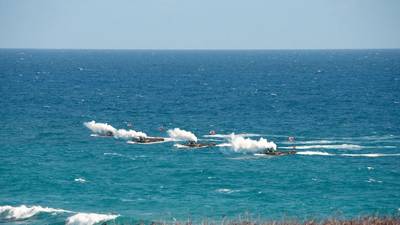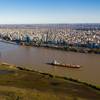RIMPAC Naval Exercise Brings Together 'Capable Adaptive Partners' from 28 Nations
The 2022 biennial, multi-national Rim of the Pacific's (RIMPAC) exercise has come to a close.
This year’s exercise with the theme of “Capable Adaptive Partners,” featured 26 participating nations and 38 surface ships, three submarines, more than 30 uncrewed systems, approximately 170 aircraft, and more than 25,000 personnel.
RIMPAC 2022 featured a wide range of capabilities--projecting the inherent flexibility of maritime forces and helping to promote a free and open Indo-Pacific, and took place in and around the Hawaiian Islands and Southern California, June 29 to Aug. 4.
During the exercise, 26 nations, 38 surface ships, four submarines, nine national land forces, more than 30 unmanned systems, approximately 170 aircraft and more than 25,000 personnel trained together while operating in and around the Hawaiian Islands and Southern California, June 29 to Aug. 4.
“By coming together as ‘Capable, Adaptive Partners,’ and in the scale that we are, we are making a statement about our commitment to work together, to foster and sustain those relationships that are critical to ensuring the safety of the sea lanes and the security of the world's interconnected oceans,” said RIMPAC 2022 Combined Task Force Commander, U.S. Navy Vice Adm. Michael Boyle.
This year’s exercise included 26 participating nations from Australia, Brunei, Canada, Chile, Colombia, Denmark, Ecuador, France, Germany, India, Indonesia, Israel, Japan, Malaysia, Mexico, Netherlands, New Zealand, Peru, the Republic of Korea, the Republic of the Philippines, Singapore, Sri Lanka, Thailand, Tonga, the United Kingdom, and the United States. Other nations sent observers, including Belgium, Fiji, Guatemala and Poland.
Exercise leadership was also multi-national. Japan Maritime Self-Defense Force Rear Admiral Toshiyuki Hirata was the exercise vice commander, and commanded the Humanitarian Assistance and Disaster Relief (HADR) portion of the exercise that operated with local hospital personnel Royal Canadian Navy Rear Adm. Christopher Robinson, served as Vice Adm. Boyle’s deputy commander.
Republic of Korea Rear Adm. Sangmin An served as the commander of the exercise’s combined amphibious task force from his flagship, USS Essex (PHD 2), assisted by his deputy, U.S. Navy Rear Adm. Michael Baze, commander, Expeditionary Strike Group (ESG) 3, with the Republic of Singapore Navy Col. Kwan Hon Chuong serving as the amphibious force’s Sea Combat Commander, and Royal Australian Navy Capt. Michael Osborn serving as the Sea Logistics Commander.
An amphibious assault was conducted on Aug. 1 at the Marine Corps Base Hawaii in Kaneohe Bay, Oahu, and served as a capstone event as RIMPAC drew to a close.
In addition to Essex, the amphibious assault force included the Republic of Korea Navy landing helicopter platform ROKS Marado (LPH-6112); the Royal Australian Navy landing helicopter dock HMAS Canberra (L02); and the Mexican Navy landing ship tank ARM Usumacinta (A412), the ex-USS Frederick (LST-1184).
USMC F/A-18 Hornets and AH-1Z and UH-1 aircraft provided fire support, and USMC CH-53E Super Stallions and MV-22 Ospreys delivered troops to the landing zone, USAF A-10 Thunderbolt IIs, a USAF MQ-9 Reaper and a USAF C-17 airlifter.
The ground assault included forces from the Republic of Korea, Mexico, Sri Lanka, Chile, Indonesia, Malaysia, the Kingdom of Tonga and the U.S.
RIMPAC Notable Accomplishments:
- Two U.S. Marine Corps MV-22 Osprey aircraft embarked in Australian amphibious ship HMAS Canberra for the whole duration of the exercise.
- While participating in RIMPAC for the first time, HMNZS Aotearoa conducted numerous Replenishment at Sea operations with partner nations including France, Australia, Canada, Malaysia and the U.S.
- Royal Malaysian Ship KD Lekir (F26) conducted their first live missile firing outside Malaysian waters.
- First embedded use of the MQ-9A and MQ-9B unmanned aerial vehicles, and the unmanned surface vessels Nomad, Ranger, Sea Hawk and Sea Hunter; with data and knowledge sharing amongst 13 countries, including Australia, Canada, Japan, Korea, Malaysia, Philippines, Peru, India, France, Chile, Mexico, Singapore and Indonesia.
- Nine nations participated in the RIMPAC Amphibious Assault (Australia, Chile, Indonesia, Malaysia, Mexico, Republic of Korea, Sri Lanka, Tonga and U.S.).














